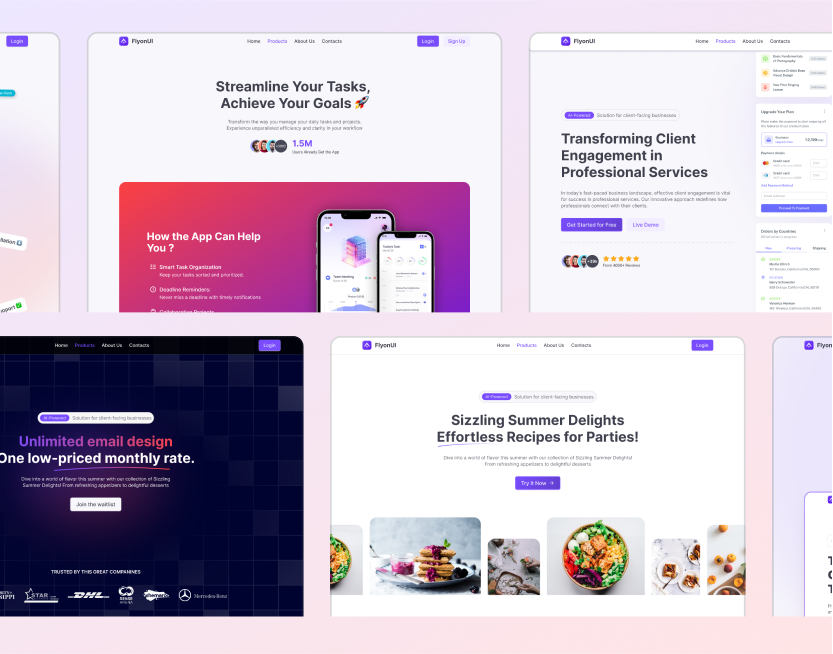customization
RTL
Learn how to setup and configure bidirectional text formats (RTL and LTR) in your project using native Tailwind CSS variants and the FlyonUI components.
RTL (right-to-left) is a text orientation used for languages such as Arabic, Hebrew, Persian, Urdu, and Yiddish, spoken by over 500 million people. It is also among the fastest-growing language groups online.
All FlyonUI components seamlessly support RTL by leveraging logical CSS properties and values, like using ms-0 instead of ml-0 and pe-4 instead of pr-4. This functionality requires Tailwind CSS v3.3.0.
In this guide, you’ll learn how to set up and configure bidirectional text formats (RTL and LTR) in your project using Tailwind CSS variants and FlyonUI components by modifying the dir attribute on the <html> element.
Before you begin, ensure you have the latest version of Tailwind CSS and FlyonUI installed.
To enable RTL support, add the dir attribute to the <html> tag in your index.html file:
<html dir="rtl">
<!-- your HTML markup -->
</html>
All FlyonUI components are fully compatible with RTL mode, utilizing Tailwind CSS’s logical properties for easy adaptability. You can test this functionality by toggling between LTR and RTL modes using the RTL button below.
Richard Payne is a remarkable individual known for his exceptional skills and expertise in various fields. With a strong background in technology and a passion for innovation, Richard has made significant contributions to the industry.
<div class="accordion accordion-shadow *:accordion-item-active:shadow-md">
<div class="accordion-item active" id="payment-arrow-right">
<button class="accordion-toggle inline-flex items-center justify-between text-start" aria-controls="payment-arrow-right-collapse" aria-expanded="true">
<div class="flex gap-4">
<div class="avatar">
<div class="size-12 rounded-md">
<img src="https://cdn.flyonui.com/fy-assets/avatar/avatar-2.png" alt="avatar" />
</div>
</div>
<div>
<p class="mb-0.5">Richard Payne</p>
<p class="text-sm text-base-content/50 font-normal">pwright@yahoo.com</p>
</div>
</div>
<span class="icon-[tabler--chevron-left] accordion-item-active:-rotate-90 size-5 shrink-0 transition-transform duration-300 rtl:-rotate-180"></span>
</button>
<div id="payment-arrow-right-collapse" class="accordion-content w-full overflow-hidden transition-[height] duration-300" aria-labelledby="payment-arrow-right" role="region">
<div class="px-5 pb-4">
<p class="text-base-content/80 font-normal">
Richard Payne is a remarkable individual known for his exceptional skills and expertise in various fields. With a strong background in technology and a passion for innovation, Richard has made significant contributions to the industry.
</p>
</div>
</div>
</div>
<div class="accordion-item" id="delivery-arrow-right">
<button class="accordion-toggle inline-flex items-center justify-between text-start" aria-controls="delivery-arrow-right-collapse" aria-expanded="false">
<div class="flex gap-4">
<div class="avatar">
<div class="size-12 rounded-md">
<img src="https://cdn.flyonui.com/fy-assets/avatar/avatar-7.png" alt="avatar" />
</div>
</div>
<div>
<p class="mb-0.5">Jordan Stevenson</p>
<p class="text-sm text-base-content/50 font-normal">wramirez@outlook.com</p>
</div>
</div>
<span class="icon-[tabler--chevron-left] accordion-item-active:-rotate-90 size-5 shrink-0 transition-transform duration-300 rtl:-rotate-180"></span>
</button>
<div id="delivery-arrow-right-collapse" class="accordion-content hidden w-full overflow-hidden transition-[height] duration-300" aria-labelledby="delivery-arrow-right" role="region">
<div class="px-5 pb-4">
<p class="text-base-content/80 font-normal">
Jordan Stevenson is a talented individual with a passion for technology and innovation. Jordan has made significant contributions to various projects and has a deep understanding of programming languages and frameworks.
</p>
</div>
</div>
</div>
<div class="accordion-item" id="cancel-arrow-right">
<button class="accordion-toggle inline-flex items-center justify-between text-start" aria-controls="cancel-arrow-right-collapse" aria-expanded="false">
<div class="flex gap-4">
<div class="avatar">
<div class="size-12 rounded-md">
<img src="https://cdn.flyonui.com/fy-assets/avatar/avatar-8.png" alt="avatar" />
</div>
</div>
<div>
<p class="mb-0.5">Nicholas Tanner</p>
<p class="text-sm text-base-content/50 font-normal">snguyen@icloud.com</p>
</div>
</div>
<span class="icon-[tabler--chevron-left] accordion-item-active:-rotate-90 size-5 shrink-0 transition-transform duration-300 rtl:-rotate-180"></span>
</button>
<div id="cancel-arrow-right-collapse" class="accordion-content hidden w-full overflow-hidden transition-[height] duration-300" aria-labelledby="cancel-arrow-right" role="region">
<div class="px-5 pb-4">
<p class="text-base-content/80 font-normal">
Nicholas Tanner is a highly skilled individual with a strong passion for technology and innovation. Nicholas has made significant contributions to numerous projects and possesses a deep understanding of various programming languages and frameworks.
</p>
</div>
</div>
</div>
</div>To add RTL support in your custom components, prepend rtl: to the necessary classes.
For example, the snippet below ensures the arrow icon flips correctly when dir="rtl", keeping the UI consistent:
<span class="icon-[tabler--chevron-left] rtl:-rotate-180"></span>
We recommend using logical properties for margins, paddings, borders, and rounded corners to keep your HTML markup clean and reduce the number of utility classes—beneficial when working with Tailwind CSS.
All FlyonUI components come with built-in RTL support. By setting the dir attribute to rtl on the <html> element, all examples in the documentation will render correctly. Explore the full range of UI components and examples in our official documentation.
